Xiaoyu Ji
Empowering Manufacturers with Privacy-Preserving AI Tools: A Case Study in Privacy-Preserving Machine Learning to Solve Real-World Problems
Jul 02, 2025Abstract:Small- and medium-sized manufacturers need innovative data tools but, because of competition and privacy concerns, often do not want to share their proprietary data with researchers who might be interested in helping. This paper introduces a privacy-preserving platform by which manufacturers may safely share their data with researchers through secure methods, so that those researchers then create innovative tools to solve the manufacturers' real-world problems, and then provide tools that execute solutions back onto the platform for others to use with privacy and confidentiality guarantees. We illustrate this problem through a particular use case which addresses an important problem in the large-scale manufacturing of food crystals, which is that quality control relies on image analysis tools. Previous to our research, food crystals in the images were manually counted, which required substantial and time-consuming human efforts, but we have developed and deployed a crystal analysis tool which makes this process both more rapid and accurate. The tool enables automatic characterization of the crystal size distribution and numbers from microscope images while the natural imperfections from the sample preparation are automatically removed; a machine learning model to count high resolution translucent crystals and agglomeration of crystals was also developed to aid in these efforts. The resulting algorithm was then packaged for real-world use on the factory floor via a web-based app secured through the originating privacy-preserving platform, allowing manufacturers to use it while keeping their proprietary data secure. After demonstrating this full process, future directions are also explored.
PowerRadio: Manipulate Sensor Measurementvia Power GND Radiation
Dec 24, 2024Abstract:Sensors are key components enabling various applications, e.g., home intrusion detection and environmental monitoring. While various software defenses and physical protections are used to prevent sensor manipulation, this paper introduces a new threat vector, PowerRadio, that bypasses existing protections and changes sensor readings from a distance. PowerRadio leverages interconnected ground (GND) wires, a standard practice for electrical safety at home, to inject malicious signals. The injected signal is coupled by the sensor's analog measurement wire and eventually survives the noise filters, inducing incorrect measurement. We present three methods to manipulate sensors by inducing static bias, periodical signals, or pulses. For instance, we show adding stripes into the captured images of a surveillance camera or injecting inaudible voice commands into conference microphones. We study the underlying principles of PowerRadio and identify its root causes: (1) the lack of shielding between ground and data signal wires and (2) the asymmetry of circuit impedance that enables interference to bypass filtering. We validate PowerRadio against a surveillance system, broadcast systems, and various sensors. We believe that PowerRadio represents an emerging threat, exhibiting the advantages of both radiated and conducted EMI, e.g., expanding the effective attack distance of radiated EMI yet eliminating the requirement of line-of-sight or approaching physically. Our insights shall provide guidance for enhancing the sensors' security and power wiring during the design phases.
PhantomLiDAR: Cross-modality Signal Injection Attacks against LiDAR
Sep 26, 2024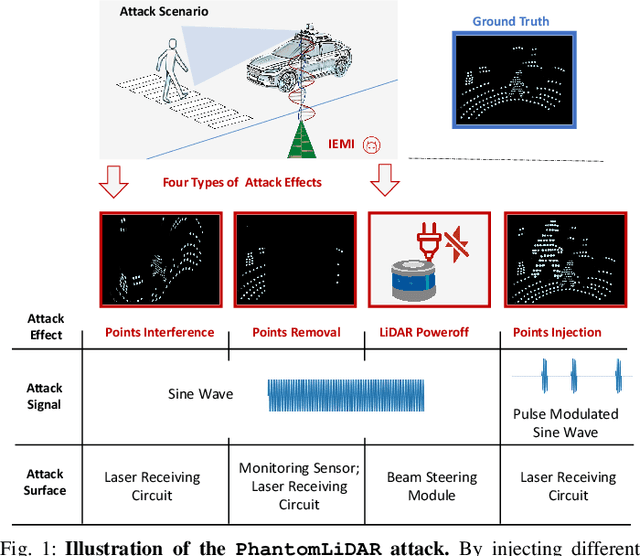
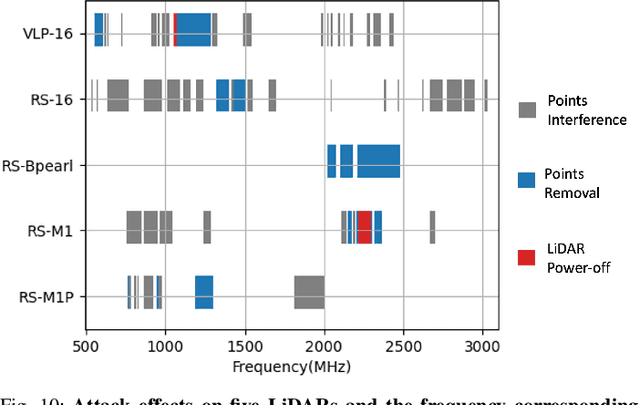
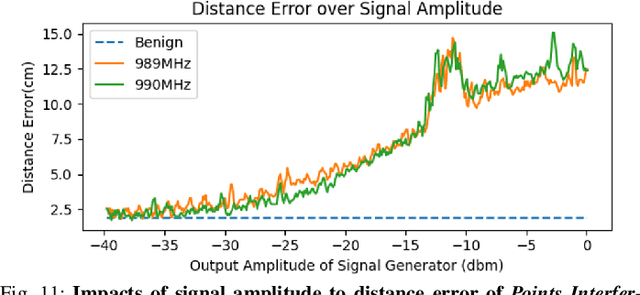
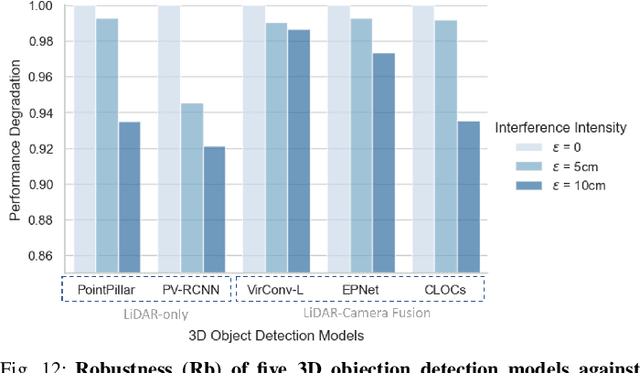
Abstract:LiDAR (Light Detection and Ranging) is a pivotal sensor for autonomous driving, offering precise 3D spatial information. Previous signal attacks against LiDAR systems mainly exploit laser signals. In this paper, we investigate the possibility of cross-modality signal injection attacks, i.e., injecting intentional electromagnetic interference (IEMI) to manipulate LiDAR output. Our insight is that the internal modules of a LiDAR, i.e., the laser receiving circuit, the monitoring sensors, and the beam-steering modules, even with strict electromagnetic compatibility (EMC) testing, can still couple with the IEMI attack signals and result in the malfunction of LiDAR systems. Based on the above attack surfaces, we propose the PhantomLiDAR attack, which manipulates LiDAR output in terms of Points Interference, Points Injection, Points Removal, and even LiDAR Power-Off. We evaluate and demonstrate the effectiveness of PhantomLiDAR with both simulated and real-world experiments on five COTS LiDAR systems. We also conduct feasibility experiments in real-world moving scenarios. We provide potential defense measures that can be implemented at both the sensor level and the vehicle system level to mitigate the risks associated with IEMI attacks. Video demonstrations can be viewed at https://sites.google.com/view/phantomlidar.
Efficient Microscopic Image Instance Segmentation for Food Crystal Quality Control
Sep 26, 2024Abstract:This paper is directed towards the food crystal quality control area for manufacturing, focusing on efficiently predicting food crystal counts and size distributions. Previously, manufacturers used the manual counting method on microscopic images of food liquid products, which requires substantial human effort and suffers from inconsistency issues. Food crystal segmentation is a challenging problem due to the diverse shapes of crystals and their surrounding hard mimics. To address this challenge, we propose an efficient instance segmentation method based on object detection. Experimental results show that the predicted crystal counting accuracy of our method is comparable with existing segmentation methods, while being five times faster. Based on our experiments, we also define objective criteria for separating hard mimics and food crystals, which could benefit manual annotation tasks on similar dataset.
SafeEar: Content Privacy-Preserving Audio Deepfake Detection
Sep 14, 2024



Abstract:Text-to-Speech (TTS) and Voice Conversion (VC) models have exhibited remarkable performance in generating realistic and natural audio. However, their dark side, audio deepfake poses a significant threat to both society and individuals. Existing countermeasures largely focus on determining the genuineness of speech based on complete original audio recordings, which however often contain private content. This oversight may refrain deepfake detection from many applications, particularly in scenarios involving sensitive information like business secrets. In this paper, we propose SafeEar, a novel framework that aims to detect deepfake audios without relying on accessing the speech content within. Our key idea is to devise a neural audio codec into a novel decoupling model that well separates the semantic and acoustic information from audio samples, and only use the acoustic information (e.g., prosody and timbre) for deepfake detection. In this way, no semantic content will be exposed to the detector. To overcome the challenge of identifying diverse deepfake audio without semantic clues, we enhance our deepfake detector with real-world codec augmentation. Extensive experiments conducted on four benchmark datasets demonstrate SafeEar's effectiveness in detecting various deepfake techniques with an equal error rate (EER) down to 2.02%. Simultaneously, it shields five-language speech content from being deciphered by both machine and human auditory analysis, demonstrated by word error rates (WERs) all above 93.93% and our user study. Furthermore, our benchmark constructed for anti-deepfake and anti-content recovery evaluation helps provide a basis for future research in the realms of audio privacy preservation and deepfake detection.
SafeGen: Mitigating Unsafe Content Generation in Text-to-Image Models
Apr 10, 2024



Abstract:Text-to-image (T2I) models, such as Stable Diffusion, have exhibited remarkable performance in generating high-quality images from text descriptions in recent years. However, text-to-image models may be tricked into generating not-safe-for-work (NSFW) content, particularly in sexual scenarios. Existing countermeasures mostly focus on filtering inappropriate inputs and outputs, or suppressing improper text embeddings, which can block explicit NSFW-related content (e.g., naked or sexy) but may still be vulnerable to adversarial prompts inputs that appear innocent but are ill-intended. In this paper, we present SafeGen, a framework to mitigate unsafe content generation by text-to-image models in a text-agnostic manner. The key idea is to eliminate unsafe visual representations from the model regardless of the text input. In this way, the text-to-image model is resistant to adversarial prompts since unsafe visual representations are obstructed from within. Extensive experiments conducted on four datasets demonstrate SafeGen's effectiveness in mitigating unsafe content generation while preserving the high-fidelity of benign images. SafeGen outperforms eight state-of-the-art baseline methods and achieves 99.1% sexual content removal performance. Furthermore, our constructed benchmark of adversarial prompts provides a basis for future development and evaluation of anti-NSFW-generation methods.
CamPro: Camera-based Anti-Facial Recognition
Dec 30, 2023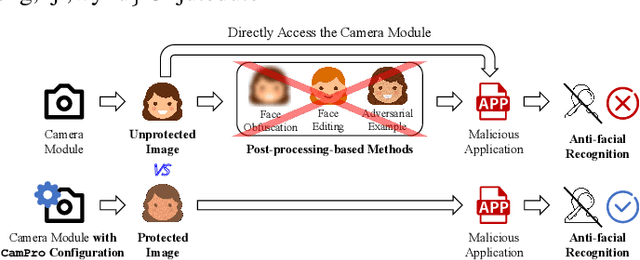
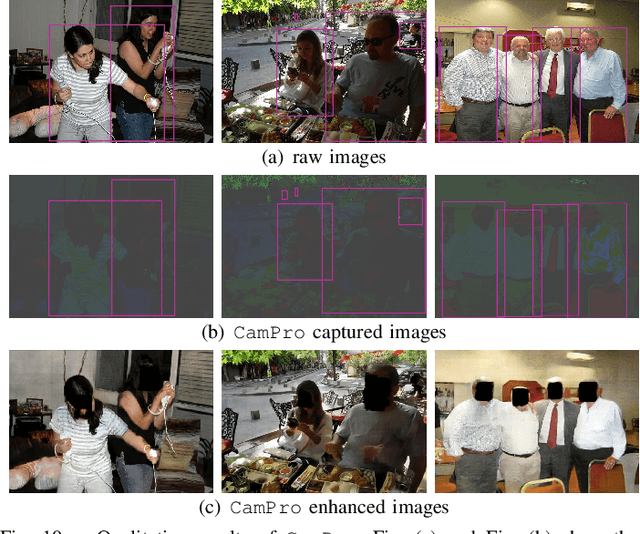
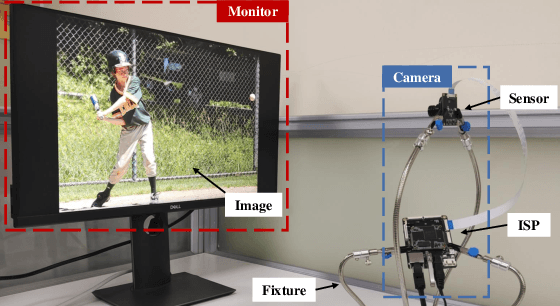
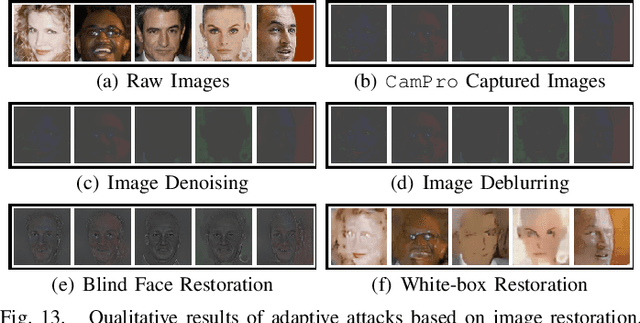
Abstract:The proliferation of images captured from millions of cameras and the advancement of facial recognition (FR) technology have made the abuse of FR a severe privacy threat. Existing works typically rely on obfuscation, synthesis, or adversarial examples to modify faces in images to achieve anti-facial recognition (AFR). However, the unmodified images captured by camera modules that contain sensitive personally identifiable information (PII) could still be leaked. In this paper, we propose a novel approach, CamPro, to capture inborn AFR images. CamPro enables well-packed commodity camera modules to produce images that contain little PII and yet still contain enough information to support other non-sensitive vision applications, such as person detection. Specifically, CamPro tunes the configuration setup inside the camera image signal processor (ISP), i.e., color correction matrix and gamma correction, to achieve AFR, and designs an image enhancer to keep the image quality for possible human viewers. We implemented and validated CamPro on a proof-of-concept camera, and our experiments demonstrate its effectiveness on ten state-of-the-art black-box FR models. The results show that CamPro images can significantly reduce face identification accuracy to 0.3\% while having little impact on the targeted non-sensitive vision application. Furthermore, we find that CamPro is resilient to adaptive attackers who have re-trained their FR models using images generated by CamPro, even with full knowledge of privacy-preserving ISP parameters.
TPatch: A Triggered Physical Adversarial Patch
Dec 30, 2023



Abstract:Autonomous vehicles increasingly utilize the vision-based perception module to acquire information about driving environments and detect obstacles. Correct detection and classification are important to ensure safe driving decisions. Existing works have demonstrated the feasibility of fooling the perception models such as object detectors and image classifiers with printed adversarial patches. However, most of them are indiscriminately offensive to every passing autonomous vehicle. In this paper, we propose TPatch, a physical adversarial patch triggered by acoustic signals. Unlike other adversarial patches, TPatch remains benign under normal circumstances but can be triggered to launch a hiding, creating or altering attack by a designed distortion introduced by signal injection attacks towards cameras. To avoid the suspicion of human drivers and make the attack practical and robust in the real world, we propose a content-based camouflage method and an attack robustness enhancement method to strengthen it. Evaluations with three object detectors, YOLO V3/V5 and Faster R-CNN, and eight image classifiers demonstrate the effectiveness of TPatch in both the simulation and the real world. We also discuss possible defenses at the sensor, algorithm, and system levels.
Exploring Adversarial Robustness of LiDAR-Camera Fusion Model in Autonomous Driving
Dec 03, 2023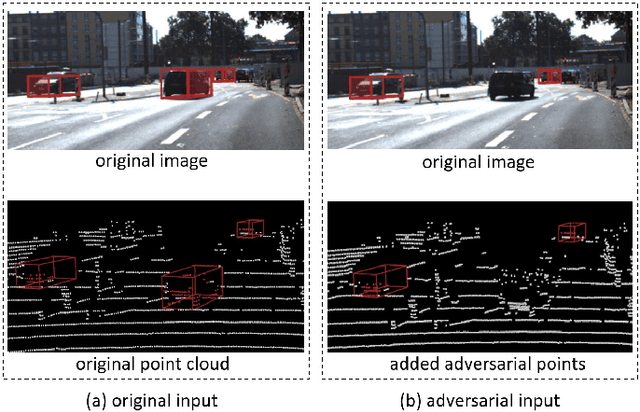

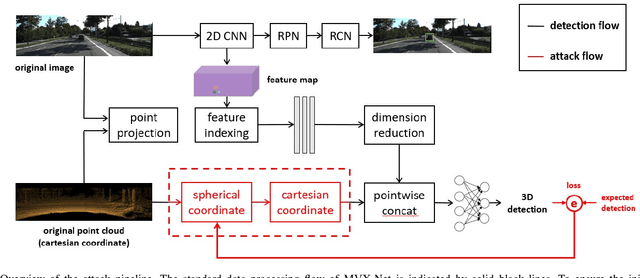
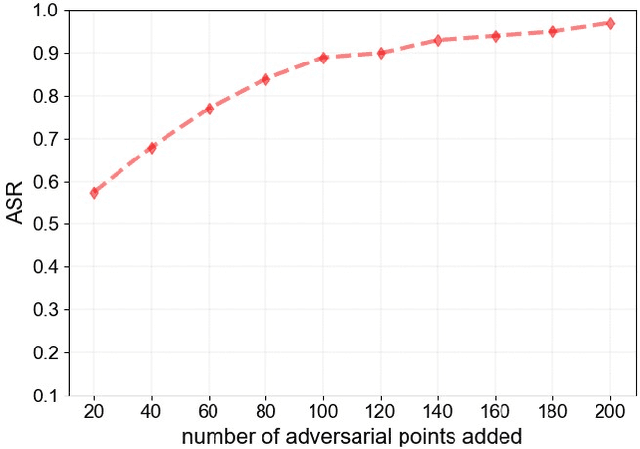
Abstract:Our study assesses the adversarial robustness of LiDAR-camera fusion models in 3D object detection. We introduce an attack technique that, by simply adding a limited number of physically constrained adversarial points above a car, can make the car undetectable by the fusion model. Experimental results reveal that even without changes to the image data channel, the fusion model can be deceived solely by manipulating the LiDAR data channel. This finding raises safety concerns in the field of autonomous driving. Further, we explore how the quantity of adversarial points, the distance between the front-near car and the LiDAR-equipped car, and various angular factors affect the attack success rate. We believe our research can contribute to the understanding of multi-sensor robustness, offering insights and guidance to enhance the safety of autonomous driving.
Inaudible Adversarial Perturbation: Manipulating the Recognition of User Speech in Real Time
Aug 03, 2023



Abstract:Automatic speech recognition (ASR) systems have been shown to be vulnerable to adversarial examples (AEs). Recent success all assumes that users will not notice or disrupt the attack process despite the existence of music/noise-like sounds and spontaneous responses from voice assistants. Nonetheless, in practical user-present scenarios, user awareness may nullify existing attack attempts that launch unexpected sounds or ASR usage. In this paper, we seek to bridge the gap in existing research and extend the attack to user-present scenarios. We propose VRIFLE, an inaudible adversarial perturbation (IAP) attack via ultrasound delivery that can manipulate ASRs as a user speaks. The inherent differences between audible sounds and ultrasounds make IAP delivery face unprecedented challenges such as distortion, noise, and instability. In this regard, we design a novel ultrasonic transformation model to enhance the crafted perturbation to be physically effective and even survive long-distance delivery. We further enable VRIFLE's robustness by adopting a series of augmentation on user and real-world variations during the generation process. In this way, VRIFLE features an effective real-time manipulation of the ASR output from different distances and under any speech of users, with an alter-and-mute strategy that suppresses the impact of user disruption. Our extensive experiments in both digital and physical worlds verify VRIFLE's effectiveness under various configurations, robustness against six kinds of defenses, and universality in a targeted manner. We also show that VRIFLE can be delivered with a portable attack device and even everyday-life loudspeakers.
 Add to Chrome
Add to Chrome Add to Firefox
Add to Firefox Add to Edge
Add to Edge